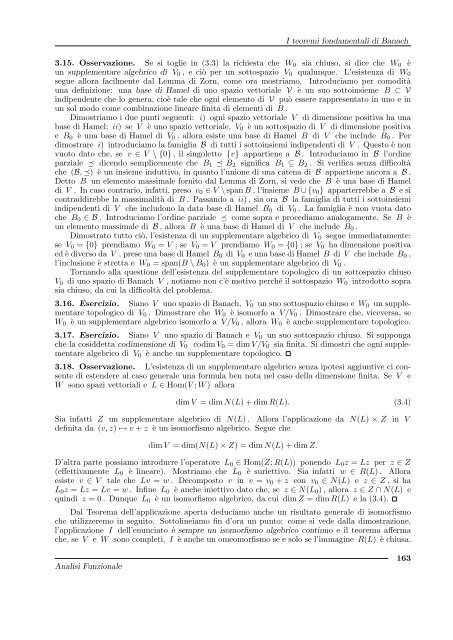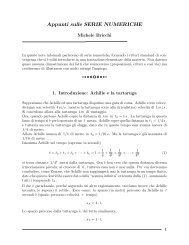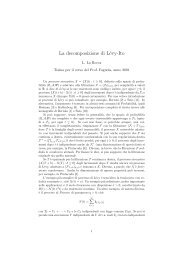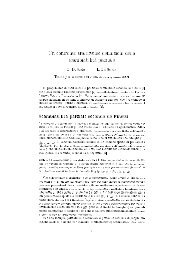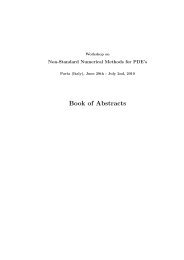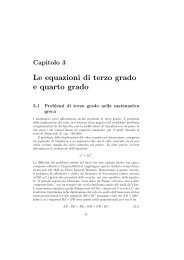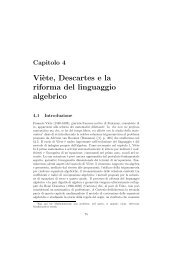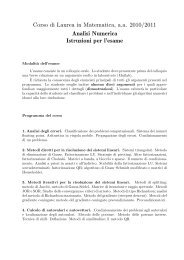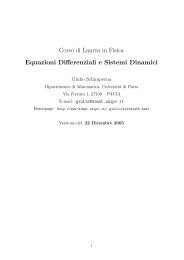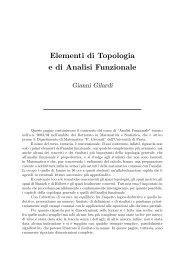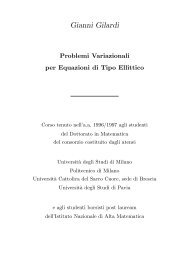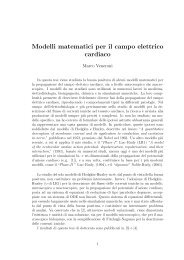G. Gilardi, Analisi Funzionale - Dipartimento di Matematica
G. Gilardi, Analisi Funzionale - Dipartimento di Matematica
G. Gilardi, Analisi Funzionale - Dipartimento di Matematica
You also want an ePaper? Increase the reach of your titles
YUMPU automatically turns print PDFs into web optimized ePapers that Google loves.
I teoremi fondamentali <strong>di</strong> Banach<br />
3.15. Osservazione. Se si toglie in (3.3) la richiesta che W0 sia chiuso, si <strong>di</strong>ce che W0 è<br />
un supplementare algebrico <strong>di</strong> V0 , e ciò per un sottospazio V0 qualunque. L’esistenza <strong>di</strong> W0<br />
segue allora facilmente dal Lemma <strong>di</strong> Zorn, come ora mostriamo. Introduciamo per como<strong>di</strong>tà<br />
una definizione: una base <strong>di</strong> Hamel <strong>di</strong> uno spazio vettoriale V è un suo sottoinsieme B ⊂ V<br />
in<strong>di</strong>pendente che lo genera, cioè tale che ogni elemento <strong>di</strong> V può essere rappresentato in uno e in<br />
un sol modo come combinazione lineare finita <strong>di</strong> elementi <strong>di</strong> B .<br />
Dimostriamo i due punti seguenti: i) ogni spazio vettoriale V <strong>di</strong> <strong>di</strong>mensione positiva ha una<br />
base <strong>di</strong> Hamel; ii) se V è uno spazio vettoriale, V0 è un sottospazio <strong>di</strong> V <strong>di</strong> <strong>di</strong>mensione positiva<br />
e B0 è una base <strong>di</strong> Hamel <strong>di</strong> V0 , allora esiste una base <strong>di</strong> Hamel B <strong>di</strong> V che include B0 . Per<br />
<strong>di</strong>mostrare i) introduciamo la famiglia B <strong>di</strong> tutti i sottoinsiemi in<strong>di</strong>pendenti <strong>di</strong> V . Questo è non<br />
vuoto dato che, se v ∈ V \ {0} , il singoletto {v} appartiene a B . Introduciamo in B l’or<strong>di</strong>ne<br />
parziale � <strong>di</strong>cendo semplicemente che B1 � B2 significa B1 ⊆ B2 . Si verifica senza <strong>di</strong>fficoltà<br />
che (B, �) è un insieme induttivo, in quanto l’unione <strong>di</strong> una catena <strong>di</strong> B appartiene ancora a B .<br />
Detto B un elemento massimale fornito dal Lemma <strong>di</strong> Zorn, si vede che B è una base <strong>di</strong> Hamel<br />
<strong>di</strong> V . In caso contrario, infatti, preso v0 ∈ V \ span B , l’insieme B ∪ {v0} apparterrebbe a B e si<br />
contrad<strong>di</strong>rebbe la massimalità <strong>di</strong> B . Passando a ii) , sia ora B la famiglia <strong>di</strong> tutti i sottoinsiemi<br />
in<strong>di</strong>pendenti <strong>di</strong> V che includono la data base <strong>di</strong> Hamel B0 <strong>di</strong> V0 . La famiglia è non vuota dato<br />
che B0 ∈ B . Introduciamo l’or<strong>di</strong>ne parziale � come sopra e proce<strong>di</strong>amo analogamente. Se B è<br />
un elemento massimale <strong>di</strong> B , allora B è una base <strong>di</strong> Hamel <strong>di</strong> V che include B0 .<br />
Dimostrato tutto ciò, l’esistenza <strong>di</strong> un supplementare algebrico <strong>di</strong> V0 segue imme<strong>di</strong>atamente:<br />
se V0 = {0} pren<strong>di</strong>amo W0 = V ; se V0 = V pren<strong>di</strong>amo W0 = {0} ; se V0 ha <strong>di</strong>mensione positiva<br />
ed è <strong>di</strong>verso da V , prese una base <strong>di</strong> Hamel B0 <strong>di</strong> V0 e una base <strong>di</strong> Hamel B <strong>di</strong> V che include B0 ,<br />
l’inclusione è stretta e W0 = span(B \ B0) è un supplementare algebrico <strong>di</strong> V0 .<br />
Tornando alla questione dell’esistenza del supplementare topologico <strong>di</strong> un sottospazio chiuso<br />
V0 <strong>di</strong> uno spazio <strong>di</strong> Banach V , notiamo non c’è motivo perché il sottospazio W0 introdotto sopra<br />
sia chiuso, da cui la <strong>di</strong>fficoltà del problema.<br />
3.16. Esercizio. Siano V uno spazio <strong>di</strong> Banach, V0 un suo sottospazio chiuso e W0 un supplementare<br />
topologico <strong>di</strong> V0 . Dimostrare che W0 è isomorfo a V/V0 . Dimostrare che, viceversa, se<br />
W0 è un supplementare algebrico isomorfo a V/V0 , allora W0 è anche supplementare topologico.<br />
3.17. Esercizio. Siano V uno spazio <strong>di</strong> Banach e V0 un suo sottospazio chiuso. Si supponga<br />
che la cosiddetta co<strong>di</strong>mensione <strong>di</strong> V0 co<strong>di</strong>m V0 = <strong>di</strong>m V/V0 sia finita. Si <strong>di</strong>mostri che ogni supplementare<br />
algebrico <strong>di</strong> V0 è anche un supplementare topologico.<br />
3.18. Osservazione. L’esistenza <strong>di</strong> un supplementare algebrico senza ipotesi aggiuntive ci consente<br />
<strong>di</strong> estendere al caso generale una formula ben nota nel caso della <strong>di</strong>mensione finita. Se V e<br />
W sono spazi vettoriali e L ∈ Hom(V ; W ) allora<br />
<strong>di</strong>m V = <strong>di</strong>m N(L) + <strong>di</strong>m R(L). (3.4)<br />
Sia infatti Z un supplementare algebrico <strong>di</strong> N(L) . Allora l’applicazione da N(L) × Z in V<br />
definita da (v, z) ↦→ v + z è un isomorfismo algebrico. Segue che<br />
<strong>di</strong>m V = <strong>di</strong>m(N(L) × Z) = <strong>di</strong>m N(L) + <strong>di</strong>m Z.<br />
D’altra parte possiamo introdurre l’operatore L0 ∈ Hom(Z; R(L)) ponendo L0z = Lz per z ∈ Z<br />
(effettivamente L0 è lineare). Mostriamo che L0 è suriettivo. Sia infatti w ∈ R(L) . Allora<br />
esiste v ∈ V tale che Lv = w . Decomposto v in v = v0 + z con v0 ∈ N(L) e z ∈ Z , si ha<br />
L0z = Lz = Lv = w . Infine L0 è anche iniettivo dato che, se z ∈ N(L0) , allora z ∈ Z ∩ N(L) e<br />
quin<strong>di</strong> z = 0 . Dunque L0 è un isomorfismo algebrico, da cui <strong>di</strong>m Z = <strong>di</strong>m R(L) e la (3.4).<br />
Dal Teorema dell’applicazione aperta deduciamo anche un risultato generale <strong>di</strong> isomorfismo<br />
che utilizzeremo in seguito. Sottolineiamo fin d’ora un punto: come si vede dalla <strong>di</strong>mostrazione,<br />
l’applicazione I dell’enunciato è sempre un isomorfismo algebrico continuo e il teorema afferma<br />
che, se V e W sono completi, I è anche un omeomorfismo se e solo se l’immagine R(L) è chiusa.<br />
<strong>Analisi</strong> <strong>Funzionale</strong><br />
163


